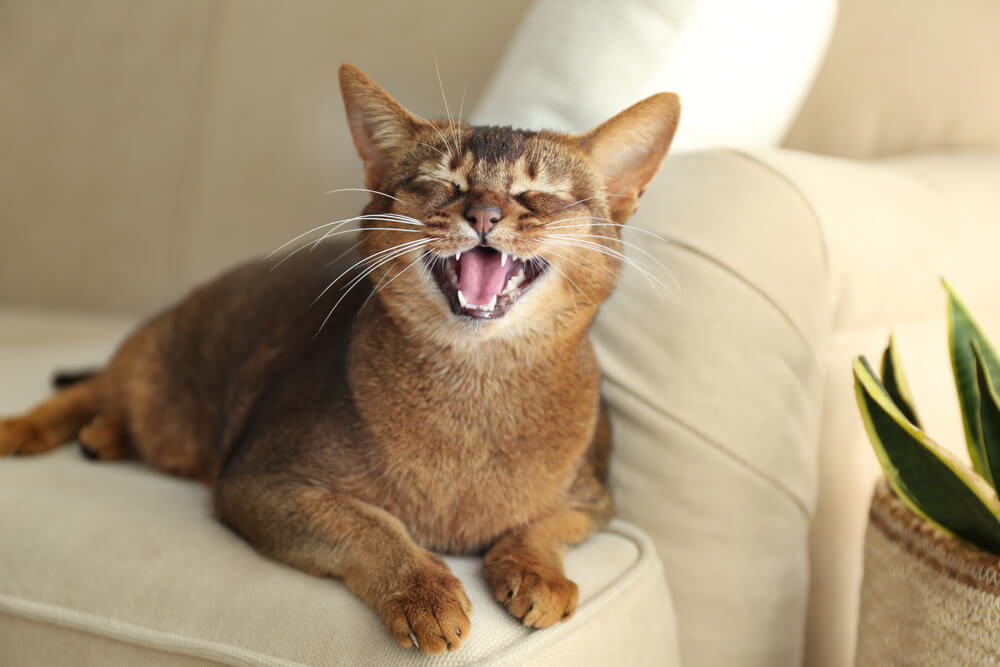Cats speak volumes through both body language and vocalization. Some breeds are loquacious, such as the Siamese,1 while others are more spare with words. More than 21 distinct types of vocalizations have been identified in the domestic cat, expressing the range from fear to contentment.2 So when your gregarious little greeter gives you a weak welcome, you may wonder why they are suddenly soft-spoken.
We’ve all had a hoarse voice after a day of cheering our favorite team or when cold season strikes. We typically pop in a throat lozenge or brew some tea with honey to soothe our vocal woes. Keep reading to learn some reasons why your cat’s meow may sound raspy, and what you can do to help when your tabby is not so gabby.
Why Does My Cat’s Meow Sound Weak and Raspy?
There are six main reasons your cat’s meow may sound weak and raspy:
- Over use
- Infectious laryngitis
- Air pollution
- Trauma or Foreign Material
- Tumors
- A few less common causes (laryngeal paralysis, recent intubation for surgery or dental procedures, congenital abnormalities, surgical complications, or neuromuscular and Autoimmune disorders)
Read on to learn more about each possible cause for your cat’s hoarseness, as well as what you should do if your cat’s meow changes.
1. Over-use
If you’ve ever been to a sporting event, concert, or party where you cheered, sang, or gossiped with gusto, you know that our vocals have limits. Your voice may become raspy and weak by bedtime. The same can occur with cats. Usually the circumstances are more distressing than fun. A cat stuck under a porch, injured, or lost may repeatedly vocalize due to fear, pain, or to call for help.3 If you find your kitty stuck in a tree after hours of searching, don’t be surprised if she temporarily loses the gift of gab.
2. Infectious Laryngitis
Cats with infectious laryngitis usually have more than a raspy voice. Nasal congestion, sneezing, discharge from the eyes and nose, poor appetite, and lethargy may accompany a weak voice.4 Affected cats may have difficulty breathing and emit a high-pitched sound on inhalation.5 Just as we hide under the covers and turn away food when illness strikes, so do cats.
Feline herpes virus and calicivirus are two potential causes of infectious laryngitis.6 Your veterinarian vaccinates kittens and cats for these viruses, but often cats have already been exposed in shelters or by their mothers.7 Some viruses can hide in the body until a cat becomes emotionally or physically stressed.89 Luckily there are treatments to target infections, speed up recovery, and reduce frequency of recurrence. Stress management through pheromones, enrichment, and even cat towers all may help reduce recurrence of viral infections.
3. Air Pollution
Smoke, construction particles, dust, and molds can all lead to irritant-induced laryngitis.10 If your kitty’s meow has changed since your roommate started smoking, it’s time to enforce some clean air ground rules. Even an adventure roaming through the attic of an old home can cause a case of the whispers. Removing either the irritant or your cat from the environment should lead to a return of the normal purr.
4. Trauma or Foreign Material
Traumatic injuries to the neck can impact the larynx, leading to a voice change.11 There may be no external sign of trauma such as an open wound. Cats that go outside are more susceptible to injury through fights with neighborhood pets or wild animals, or even being hit by a car.12
Cats may sustain injury from normal predatory activity. For example, if they snack on a bird or mouse, the hard bits can cause trauma to the larynx, leading to swelling or an abscess. Sometimes objects such as bones, parts of toys, or hairballs13 can become lodged in the upper airway, causing pain, voice change, and difficulty breathing and swallowing.14 A veterinarian will be able to identify signs of trauma, foreign material, or abscesses with a laryngoscope, endoscope, and X-rays.
4. Tumors
Tumors, both benign and malignant, can affect the larynx. Voice changes may be the first clue. Cancers of the surrounding nerves may also be to blame. Your vet will need to take X-rays and run lab tests to diagnose cancer. Chemotherapy can often improve quality of life and lifespan.15
6. Less Frequent Causes
Additional reasons why a cat may have a raspy or weak voice are much less common, but important to consider.1617
- Laryngeal paralysis
- Recent intubation for surgery or dental procedures
- Congenital abnormalities
- Surgical complications
- Neuromuscular and Autoimmune disorders
What Should You Do If Your Cat’s Meow Changes?
If your cat’s meow comes out sounding like she just gargled her kitty litter, it’s time to call your veterinarian. Be sure to tell them when the voice change began, if there has been exposure to other cats, and whether or not there are potential irritants in the home. These may include second-hand cigarette smoke, fireplace smoke, dust from a renovation, or even strong cleaning fluid fumes.
Recently adopted, stressed, or young cats are more likely to have an upper respiratory infection.18 Older cats are more prone to tumors.19 Your veterinarian will consider your cat’s age, history, and other clinical signs when diagnosing the cause for a weak voice. Often sedation is required to perform a laryngeal exam and X-rays. They may swab the nasal cavity and run bloodwork. Once a diagnosis is made, medication, surgery, or other therapy can often lead to recovery.
Remember that when your chatty companion clams up, a trip to the vet may be needed to distinguish minor irritation from a major meow malfunction. In most cases, a few days of soft food, water, and low stress can help your kitty regain her full vocal repertoire.
Article Sources
Pet News Daily uses only high-quality sources, including peer-reviewed studies, to support the facts within our articles. Read our editorial process to learn more about how we fact-check and keep our content accurate, reliable, and trustworthy.
- Breed portrait of the Siamese cat. Cat Fanciers’ Federation, Inc. Accessed February 18, 2022.
- Tavernier C, Ahmed S, Houpt KA, Yeon SC. Feline vocal communication. J Vet Sci. 2020;21(1):e18. doi:10.4142/jvs.2020.21.e18
- Kemp MH. Laryngeal disorders in cats. MSD Veterinary Manual. Updated October 2020. Accessed February 18, 2022.
- Brooks W. Upper respiratory infection in cats. Veterinary Information Network, Inc. January 1, 2001. Updated July 28, 2020. Accessed February 18, 2022.
- Kemp MH. Laryngeal disorders in cats. MSD Veterinary Manual. Updated October 2020. Accessed February 18, 2022.
- A change of voice. CatWatch. December 20, 2019. Updated January 16, 2020. Accessed February 18, 2022.
- Stone AE, Brummet GO, Carozza EM, et al. 2020 AAHA/AAFP Feline Vaccination Guidelines. J Feline Med Surg. 2020;22(9):813-830. doi:10.1177/1098612X20941784
- Thiry E, Addie D, Belák S, et al. Feline herpesvirus infection. ABCD guidelines on prevention and management. J Feline Med Surg. 2009;11(7):547-555. doi:10.1016/j.jfms.2009.05.003
- McDonnel SJ, Sparger EE, Murphy BG. Feline immunodeficiency virus latency. Retrovirology. 2013;10:69. doi:10.1186/1742-4690-10-69
- A change of voice. CatWatch. December 20, 2019. Updated January 16, 2020. Accessed February 18, 2022.
- Kemp MH. Laryngeal disorders in cats. MSD Veterinary Manual. Updated October 2020. Accessed February 18, 2022.
- Tan SML, Stellato AC, Niel L. Uncontrolled outdoor access for cats: an assessment of risks and benefits. Animals (Basel). 2020;10(2):258. doi:10.3390/ani10020258
- Haynes KJ, Anderson SE, Laszlo MP. Nasopharyngeal trichobezoar foreign body in a cat. J Feline Med Surg. 2010;12(11):878-881. doi:10.1016/j.jfms.2010.09.008
- Kemp MH. Laryngeal disorders in cats. MSD Veterinary Manual. Updated October 2020. Accessed February 18, 2022.
- A change of voice. CatWatch. December 20, 2019. Updated January 16, 2020. Accessed February 18, 2022.
- Kemp MH. Laryngeal disorders in cats. MSD Veterinary Manual. Updated October 2020. Accessed February 18, 2022.
- A change of voice. CatWatch. December 20, 2019. Updated January 16, 2020. Accessed February 18, 2022.
- Respiratory infections. Cornell Feline Health Center. Updated June 2018. Accessed February 18, 2022.
- Senior pets. AVMA. Accessed February 18, 2022.

